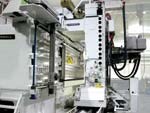Making Profilers More Productive
The trend in aircraft design is larger monolithic aluminum components that are lighter and stiffer than counterparts that are assembled from smaller pieces. Problem is, the larger, more complex parts necessitate significantly longer machining times on conventional horizontal-table profiling machines, underscoring the need for faster, more powerful profiling machines capable of machining a mix of such components quickly and efficiently.
Share


The trend in aircraft design is larger monolithic aluminum components that are lighter and stiffer than counterparts that are assembled from smaller pieces. Problem is, the larger, more complex parts necessitate significantly longer machining times on conventional horizontal-table profiling machines, underscoring the need for faster, more powerful profiling machines capable of machining a mix of such components quickly and efficiently.
Ingersoll Milling Machine Co. recently introduced a second-generation, high speed profiling machine for the aircraft industry that incorporates at least two features that improve productivity to the point that they will probably become standard in all such future machines. Called the High Velocity Profiler (HVP), the machine is capable of simultaneous five-axis machining of parts at spindle speeds up to 20,000 rpm.
The machine is not only fast, but it is also capable of taking hefty cuts. It can achieve metal removal rates up to 6,440 cm3/min., partly due to a 75 kW (100 hp), 20,000-rpm, fluid bearing spindle Ingersoll designed especially for the HVP. The fluid bearing spindle runs on an externally pressurized fluid (oil) film. Unlike conventional mechanical ball bearings, it does not wear under normal operating conditions, resulting in long bearing life. Also, since the fluid bearing is externally pressurized, the spindle can run over the entire speed range (0 to 100 percent) without loss of bearing stiffness. The dynamic stiffness of the fluid bearing spindle is 5-6 times greater than that of mechanical bearing spindles, which makes possible significantly higher metal removal rates.
Fluid bearing spindles are free of the vibration created by conventional ball bearing spindles. As a result, tools last longer. Fluid bearing spindles also have better concentricity. Tools run truer, which permits a more uniform distribution of the load on the tool's cutting edges. Finally, fluid bearing spindles reduce or eliminate chatter that can cause premature tool failure through micro-chipping of the sharp cutting edges.
It does not make a lot of sense to have a high speed spindle if the machine stands idle for long periods while machined spars, wing panels, and so forth are manually unloaded and replaced with fresh billets or plate sections. Thus, the automated load-unload features designed for the HVP multiply the value of the machine's productivity in the cut.
To begin with, the aluminum plate sections are machined standing on edge. They are secured on pallets that carry them in and out of the profiler's machining area. The profiler includes horizontal and vertical pallet handling components that accommodate totally automated material handling and, just as important, expedite loading and unloading to minimize machine idle time. Pallet-handling components shown in the drawing include a two-position (vertical) pallet transporter and a setup platform at right for loading pallets in a horizontal position.
According to Ingersoll, the HVP delivers productivity increases ranging from 4:1 to 11:1 over conventional gantry-type, vertical spindle profilers. Spars that require 50 hours of machining on the conventional machines can now be done in slightly more than 5 hours on the HVP. In a demonstration involving the machining of an aircraft wing section from a 109 by 23 ½ by 3-inch billet of 7475-T7351 aluminum alloy (tough to machine), the rough and finish machining (performed at 18,000 rpm and 16,500 rpm respectively) totaled about 70 minutes. That compares to 10 hours of machining time that was used to produce the part on a conventional profiling machine. Ingersoll points out that the HVP, with its higher cutting rate and automated load-unload capability, can perform the work of several older horizontal-table profilers, with corresponding savings in labor and plant space.
The HVP is also available with a 40,000 rpm, 80-kW, fluid bearing spindle and automatic spindle changing. The in-line fluid bearing spindle can be used for five-axis contouring cuts and can be replaced automatically by a right-angle head for five-sided machining.
Related Content
Machining with a Mission
Learn how veteran-owned shop Win-Tech not only excels in aerospace and defense manufacturing with CMMC level two compliance, but also transforms lives by hiring veterans and encouraging students to explore manufacturing.
Read MoreRoughing First: New Strategies for Blisk Machining
Aerospace shops looking to cut cycle time and tool wear on integrally bladed rotors often focus on finishing. But rethinking the roughing stage can increase how much material can be safely removed while accelerating throughput.
Read MoreHow a Custom ERP System Drives Automation in Large-Format Machining
Part of Major Tool’s 52,000 square-foot building expansion includes the installation of this new Waldrich Coburg Taurus 30 vertical machining center.
Read MoreHow to Meet Aerospace’s Material Challenges and More at IMTS
Succeeding in aerospace manufacturing requires high-performing processes paired with high-performance machine tools. IMTS can help you find both.
Read More




















